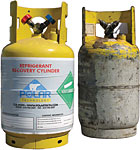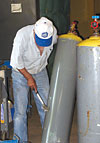
More contractors are recovering refrigerant, but it’s still not at the pace needed to be ready for the Department of Energy phaseout.
Perhaps the rather grim assessment involving the future availability of R-22 will spur more people to properly recover refrigerant in the field. Based on EPA estimates, the projected servicing needs in the United States for the air conditioning and refrigeration sector will face an imminent shortfall if the recycle and reclaim rate does not increase to 20 percent. Industry estimates for 2007 point to a reclaim rate of only 5-7 percent.
The most recent EPA estimated service demand and the 58 percent decrease in R-22 production allowances as of January 2010 will most likely result in a shortfall of R-22 as early as next year. As illustrated by DuPont in its “R-22 Outlook” bulletin, the company states that in 2010, R-22 service demand will exceed allowed virgin R-22 supply by 27.5 million pounds, based on the latest EPA demand projections. So where will the extra R-22 come from to meet market demand? EPA and industry experts hope that recovered refrigerant will be able to satisfy the need for R-22.
BREAKING DOWN BARRIERS
If the law states that refrigerant cannot be vented, then why isn’t more recovery taking place in the field? According to Marc Richburg, national sales manager, ICOR International, Inc. – Refri-Claim™ Division, Indianapolis, contractors may not be recovering and recycling refrigerant due in part to weak enforcement by the EPA and lack of repercussions by disregarding venting or leak rate regulations. “Many contractors also struggle to find a local program that simplifies the process and alleviates the hassles.”ICOR aims to eliminate that last obstacle to recycling by offering Simple Swap™, which is an over-the-counter refrigerant cylinder swap program designed to reduce liability and simplify the overall process. The program does not require “self-pump-down” of tanks, cylinder maintenance is included, and all recovered refrigerant is accepted, regardless of its condition.
“Our program eliminates many of the hassles associated in the past with the reclaim process,” said Richburg. “By providing the contractor with a simplified over-the-counter solution, we are enabling them more time in the field and less time pumping down or worrying about cylinder maintenance. We also free up valuable space in the shop and trucks, which may be currently occupied by unnecessary recovery cylinders and equipment.”
USA Refrigerants, Nanuet, N.Y., is also adept at making the recovery/recycling process easier for contractors. The company has an extensive R-22 buyback program available throughout the continental United States, which pays contractors for their used and recovered R-22. Michael Mulligan, vice president, marketing and sales, USA Refrigerants, noted that the company provides cylinders to contractors who consolidate recovered R-22, pays all freight expenses to and from the contractor’s place of business, and also pays for the refrigerant. This allows contractors to be prepared for their next recovery job without making an extra trip to exchange cylinders.
“The most important benefit we offer our customers is our extensive knowledge of the R-22 market and the refrigerant market in general,” said Mulligan. “We provide our customers with insight, which allows them to make better decisions regarding their businesses.”

A clean, well vacuumed vessel is essential in guaranteeing that a contractor can adequately recover the material in a system, noted Ted Atwood, Polar Technology.
“A clean, well-vacuumed vessel is essential in guaranteeing that a contractor can adequately recover the material in a system. We have also developed larger special port valves that aid in recovery of larger systems. This has resulted in an increased efficiency of 700 percent in the rate of recovery. Each valve on a Polar cylinder has been inspected, so we are certain that a contractor is going to have the fastest recovery possible, and we guarantee no leaks, so once in the bottle, it’s safe and contained.”
DuPont has recently expanded and improved its reclaim program and continues to offer retrofit solutions to replace R-22 in existing systems. The company is also supporting industry educational initiatives to ensure that refrigerant users understand the current regulations and are able to put effective refrigerant management programs into place well in advance of the expected 2010 shortfall.
According to Joyce Wallace, North America marketing manager, DuPont Refrigerants, “With the new EPA projection, it’s becoming increasingly clear that the industry will need to rely on reclaim, recycle, and reuse of R-22 as well as retrofits of existing equipment to hydrofluorocarbon (HFC) replacement products to avoid shortfalls going forward. This will require a significant step-change in industry behavior since the estimated amount of reclaim activity in 2008 was approximately 4,500 tons vs. the 12,500 tons that represents the 20 percent shortfall in 2010.”
DuPont provides several different options of recovery/reclaim programs for their distributors to take back recovered refrigerants for reclamation. The company has recently included an online “where to reclaim” locator to help contractors, technicians, and equipment owners identify where they can return their used refrigerants (see www.refrigerants.dupont.com/manage22).

Polar Technology makes sure that contractors have ready-to-use cylinders that are free from graffiti and old decals.
DO NOT MIX AND MATCH
Recovering R-22 just makes good business sense, said Mulligan, who noted that as the economic incentives increase, more and more contractors will get onboard with refrigerant recovery. “Over the past 12 months, we have seen a substantial increase in the number of contractors inquiring about and participating in buyback programs. More importantly, we have seen an improvement in the quality of recovered refrigerant coming back. Contractors understand the importance of not mixing recovered refrigerants, and this allows them to maximize their refrigerant recovery buyback dollars.”Mixing recovered refrigerants in the field can be a big problem, and it often occurs due to a few basic mistakes that contractors unintentionally make when performing recovery. Atwood offered the following advice that contractors should consider in order to ensure a reduced risk of mixed material and faster recovery:
1.Buy enough cylinders to recover each refrigerant into a separate cylinder. The a/c trade needs to adapt to a variety of refrigerants under their management, so buy enough cylinders for each truck.
2.Have a set fee for recovery. Just like the tire or battery industry, we need to tell people we are charging an environmental fee. Consumers are prepared for this, as other industries have been doing this for over a decade.

DuPont states that in 2010, R-22 service demand will exceed allowed virgin R-22 supply by 27.5 million pounds, based on the latest EPA demand projections. (Click on the image for an enlarged view.)
4.Recover to a level sufficient to meet both EPA- and system-suggested requirements. If not enough recovery or vacuum is applied to a system, gas can be left and then vented.
5.Explain the value of recovery to system owners. If an R-22 system leaks or the refrigerant is vented, this can harm the environment. The refrigerant in a 5-ton R-22 system is the equivalent of 297 trees.
Richburg added that clearly marking each recovery cylinder with the type of refrigerant it contains can also go a long way to reducing the chance of mixing multiple refrigerants in the same recovery cylinder. “Refri-Claim provides a ring around the valve that gives the contractor an easy place to mark the refrigerant type in a cylinder. In many cases, mixed refrigerants can be separated but at an additional cost, making it less economic.”
While some contractors believe that taking the time to recover refrigerant from a system can be a hassle, the bottom line is that it is the law. And recovering and recycling refrigerant is absolutely vital if this industry wants to ensure it has enough refrigerant available to service the millions of R-22 systems that will be in place for many years to come.
Publication date:06/22/2009


Report Abusive Comment